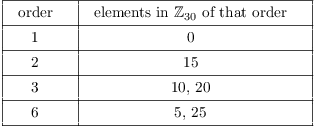Group maps ![]() are determined by
the image of
are determined by
the image of ![]() : The image is an
element whose order divides
: The image is an
element whose order divides ![]() , and all such
elements are the image of such a group map.
, and all such
elements are the image of such a group map.
Theorem.
(a) If ![]() is a group map,
then
is a group map,
then ![]() .
.
(b) If ![]() satisfies
satisfies ![]() , then there is a group map
, then there is a group map ![]() such that
such that ![]() .
.
Proof. (a) Suppose ![]() is a group map. Now
is a group map. Now
![]() in
in ![]() , so
, so
![]()
This shows that ![]() .
.
Since ![]() , I have
, I have ![]() .
.
Hence, ![]() .
.
(b) Let ![]() , and suppose
, and suppose ![]() . Define
. Define ![]() by
by
![]()
Since ![]() , I have
, I have ![]() for some
for some ![]() .
.
Now

Since g sends ![]() to 0, the Universal
Property of the Quotient produces a (unique) group map
to 0, the Universal
Property of the Quotient produces a (unique) group map ![]() defined by
defined by
![]()
Then ![]() , and
, and ![]() is the desired group map.
is the desired group map.![]()
Corollary. The number of group maps ![]() is
is ![]() .
.
Proof. The number of elements of order d in
a cyclic group is ![]() (where
(where ![]() denotes the Euler
denotes the Euler ![]() -function). The divisor sum of the Euler
-function). The divisor sum of the Euler ![]() -function is the identity:
-function is the identity:
![]()
So the number of elements whose orders divide ![]() is
is ![]() , and the theorem shows that each such
element gives rise to a group map
, and the theorem shows that each such
element gives rise to a group map ![]() .
.![]()
Example. (a) Enumerate the group maps ![]() .
.
(b) Show by direct computation that ![]() given by
given by ![]() is not a group map.
is not a group map.
(a) Since ![]() , there are 6 such maps by the
Corollary. They are determined by sending
, there are 6 such maps by the
Corollary. They are determined by sending ![]() to an element whose order divides
6.
to an element whose order divides
6.

Thus, the possible group maps ![]() have
have
![]()
For example, the group map
![]()
It is easy to determine the kernel and the image. The image is the
unique subgroup of ![]() of order 3,
so
of order 3,
so
![]()
By the First Isomorphism Theorem, the kernel must have order ![]() . The unique subgroup of
. The unique subgroup of ![]() of order 6 is
of order 6 is
![]()
(b) Consider the function ![]() given by
given by ![]() .Then
.Then
![]()
Therefore, ![]() , so f is not
a group map.
, so f is not
a group map.![]()
Copyright 2016 by Bruce Ikenaga